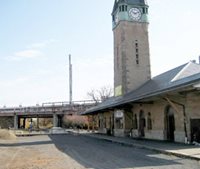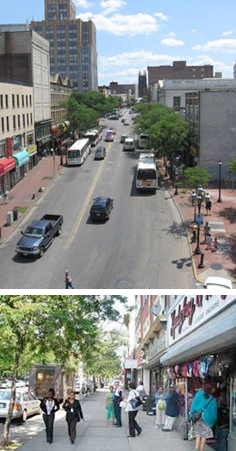 Background
Background
The NJTPA, in partnership with NJ TRANSIT, Union County and the City of Elizabeth, has developed a conceptual station area plan for the "Midtown" Elizabeth station on NJ TRANSIT's Northeast Corridor rail line. The plan is designed to leverage proposed investments in the rail station and transit system, planned redevelopment, and various multi-modal circulation needs to improve a location long-envisioned by the City as a catalyst for downtown revitalization and by NJ TRANSIT as an important regional transit hub.
The need for this study emerged from several sources. The NJTPA Strategy Refinement Study identified an Elizabeth multi-modal transit center as one of 21 places where significant regional needs could be met by studying and advancing improvments to the transportation system. NJ TRANSIT's Greater Newark Bus System Study similarly recommended a new multi-modal transit center at the Elizabeth rail station. NJ TRANSIT is currently developing plans to replace the outdated rail station with new platforms, waiting areas, and entrances and is also examining the feasibility of a future cross-county Bus Rapid Transit (BRT) system utilizing the former Central Railroad of New Jersey (CNJ) right-of-way that crosses the station area. The City is planning or constructing various redevelopment and revitalization projects around the station, including restoring the area around the former CNJ station.
Building on previous study efforts and incorporating up-to-date transportation and redevelopment plans, this study has developed an integrated plan addressing multi-modal access, safety, capacity, and land use needs. The plan also identifies opportunities to enhance the experience for passengers transferring between commuter rail and connecting transit services. AECOM provided technical consultant services for the study.
 Study Highlights
Study Highlights
Elizabeth’s rail station along Amtrak’s busy Northeast Corridor is served by 167 NJ TRANSIT Northeast Corridor Line and North Jersey Coast Line commuter trains per day, as well as over 700 local and regional buses. Situated atop an historic stone viaduct (the “arches") overlooking the city’s "Midtown" central business district, the station is accessed by several key corridors including Broad Street, Grand Street, Jersey Street and Morris Avenue. The study area extends one to two blocks out from the rail station and is generally bounded by these streets and the Elizabeth River to the west. The street network is often congested and connectivity is limited by two raised rail embankments (the Northeast Corridor Line and former CNJ "Mainline") that allow very few through-streets and intersect at a two-level bridge crossing over Broad Street.
The surrounding Midtown area contains a busy shopping district, a historic circa 1893 former CNJ rail station building, county and local government facilities, higher education institutions and a large residential population. The Elizabeth Midtown Redevelopment Plan, last amended in 2007, encompasses an under-developed area similar to the study area and permits a mix of residential, retail and office uses.
The study process included these key steps:
-
Review of materials from recent and ongoing studies to determine the current status of previous recommendations.
-
Site survey of station area traffic, parking, bus stops, pedestrian/bicycle activity, and conditions around station entrances to identify issues with safety, congestion, poor connectivity and amenities.
-
Examination of the potential for a multi-modal transit center integrating rail and bus pasenger facilities, as well as the historic former CNJ station area.
-
Identification of opportunities to improve pedestrian, bicycle, transit, and vehicular access to the station.
-
Assessment of possible new development and market opportunities at the station.
-
Development of a conceptual plan, incorporating these opportunities, for better integration of planned new rail facilities with connecting modes, and existing and future surrounding land uses.
-
Coordination with NJ TRANSIT and the City to ensure consistency with future transit, roadway and development projects.
-
Outreach to a Technical Advisory Committee and community stakeholders.
Final Report
The study summarizes the technical work and study outreach process, and contains the station area concept plan and detailed recommendations for circulation improvements and station-oriented redevelopment.
Study Status
The study was completed in September 2011.